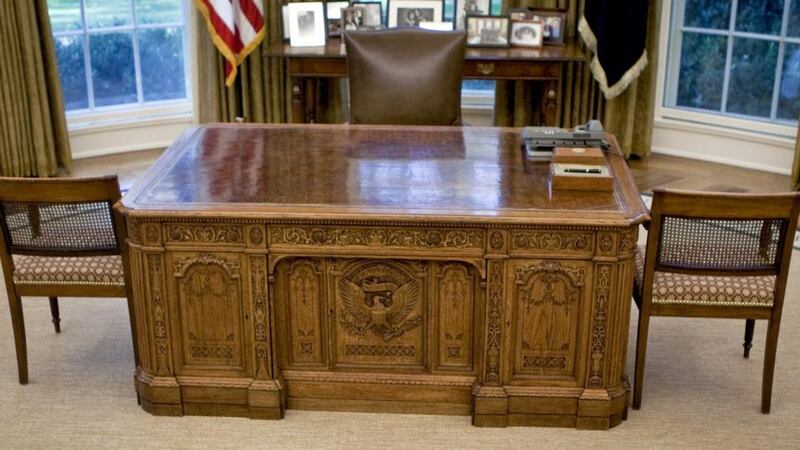You’ll remember John F Kennedy’s desk: made famous by photographs in which his children played underneath it while, above them, their father got on with the business of being the most powerful man on earth.
In fact, it wasn’t only JFK’s desk. It was first used in 1880, by Rutherford Hayes, and after him by every US president except – for some reason – Johnson, Nixon, and Ford. Obama still uses it today.
But before it became a piece of White House furniture, the desk was a ship; or at least part of a ship. And the story of how it ended up in Washington has, like JFK himself, a strong Irish flavour.

It starts in 1852, when the vessel in question, HMS Resolute, was one of five dispatched by Britain to the Canadian Arctic in a futile mission to find John Franklin and his crew, lost during one of the many attempts to navigate the Northwest Passage.
The Resolute was captained by a Tipperary man, Henry Kellett, whose first mate, George Mecham, was from what is now Cobh. Nor was Kellett the only Irish commander on the mission. Another of the ships was under the charge of Francis McClintock, from Dundalk.
And the Irish connections didn’t end there. Although Franklin was their main focus, the searchers were also keeping a look-out for Wexford-born Robert McClure: another seeker of the Northwest Passage who had not been heard of for some time.
This accumulation of Hibernian mariners might have been well diluted by the vastness of the Canadian Arctic. But as Frank Nugent writes in his book, Seek the Frozen Lands – now out in paperback – it resulted in at least one pleasantly parochial chain of circumstances.
On an earlier trip, McClintock had scrawled a message on a sandstone rock at Melville Island, a huge, uninhabited, but strategically important part of the Arctic archipelago.
This was found a year later by the stranded McClure (who had been hoping for provisions but was nonetheless impressed at seeing a note, in such a far-flung place, from a friend and compatriot). And the note McClure then left, detailing his crew’s position, was later discovered by Mecham.
As Nugent puts it: “It is a remarkable fact that on the northern polar edges of the then known world, a note left by Dundalk man McClintock [in 1851] was found by Wexford man McClure in April 1852, whose note was in turn found by Mecham, that intrepid Cobh man, in the autumn of that year.”
In any case, the upshot was a sled-based rescue mission for McClure, who went on to win glory as the Northwest Passage’s first conqueror.
In the course of not finding Franklin, meanwhile, Kellett, Mecham, and McClintock performed heroic work: mapping vast territories and setting up depots, including the “Kellett Storehouse” at Melville Island, a shelter for those stranded in future.
But by the end of 1853, they themselves were in trouble. The Resolute was badly damaged in a storm and, along with three of the other four ships, then became trapped in ice. Their individual commanders were content to wait out the winter, until a thaw set in. Unfortunately, the expedition leader, a Nova Scotian called Belcher, was not.
“Lazy [and] incompetent”, according to Nugent, Belcher ordered the ships abandoned and brought his men home. He was cleared by the resultant court-martial, because his orders had allowed maximum discretion. But his sword was handed back “in silence”, a fact apparently damning.
The now-unmanned Resolute, meanwhile, was now on course to become office furniture. Breaking free from the ice, it first drifted 1,000 miles before being commandeered by an American whaling ship.
The government in Washington subsequently returned it to Britain. But when it was finally decommissioned, Queen Victoria had an idea for an unusual, timber-based gift to the White House. Thus the “Resolute Desk” was born.
Accidental though Kennedy’s association with it may be, it’s also apt. He was himself a naval commander, and knew what it was to lose a ship. After his torpedo boat was sunk by the Japanese in 1943, he and 11 crew members had to swim for their lives – Kennedy saving a badly-burned crew-mate – and then hide on an island, surviving for a week on a diet of coconuts.
One of those coconuts also played a part in their rescue. The future president carved an SOS message on it, including the words “11 alive . . . need small boat . . . Kennedy”. This was relayed by a friendly native canoeist to the nearest Allied base, and the rest was history.
Being a naval war hero helped propel Kennedy to the White House. When he got there, he had the coconut telegram mounted as a paperweight: a suitably qualified accessory to the world’s most famous desk.
fmcnally@irishtimes.com










